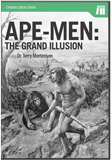
Hobbit by Birth or Disease?
National Geographic News: “‘Hobbit’ Human Was Unique Species, Wrist Bones Suggest”
A new study of the wrist bones of one “hobbit,” found among a hobbit group in 2004 in Indonesia, suggests the hobbit was a unique species, not a diseased modern human. The study is the latest contributor to a debate over the hobbits’ true status.
The hobbit’s skull size, based on remains found, was approximately the size of a grapefruit.
On one hand (excuse the pun) are researchers who claim this hobbit is sufficiently different from modern humans to occupy its own species, named Homo floresiensis. On the other hand are scientists who claim the diminutive human was diseased with microcephaly, a condition resulting in, among other problems, small head size. The hobbit’s skull size, based on remains found, was approximately the size of a grapefruit.
Matthew Tocheri, a paleoanthropologist at the Smithsonian Institution in Washington, DC, is the lead author of a Science study that examined the hobbit wrist bones, concluding that the wrists were more primitive and similar to those of gorillas, chimpanzees, and other early human ancestors (which Answers in Genesis would consider to also be apes, not human ancestors). National Geographic News reports:
Before conducting his hobbit study, Tocheri had found that a particular wrist bone is wedge-shaped in great apes and early human ancestors but is squared-off in modern humans and Neandertals. That wrist bone in the hobbit retains the wedge shape, he found.
Those from the “unique species” side of the debate add that the wrist evidence coincides with previous studies that “identified primitive shoulder joints and jawbones in the hobbit, as well as unpublished reports of primitive features in the foot.” Tocheri and his colleagues caution that more fossil specimens are needed.
However, biological anthropology curator Robert Martin of Chicago’s Field Museum (which, by the way, is no ally of creationists) says the possibility that the Indonesian fossil is a modern human has not been undone. Martin has already authored two papers arguing that the hobbit is a microcephalic human.
Martin points out that Tocheri’s study failed to compare the hobbit’s wrist bones to those of a modern human with microcephaly. Microcephaly, in addition to affecting head size, causes deformations throughout the skeletal system—including possibly affecting wrist bones.
“I stick to the suggestion that [the hobbit] is more likely to be a pathological modern human than any kind of new hominid species,” Martin said.
Microcephaly, in addition to affecting head size, causes deformations throughout the skeletal system—including possibly affecting wrist bones.
At this point, it seems the debate will go on in evolutionary circles; without more specimens, it is impossible to determine if this hobbit was abnormal or not, and scientists can only speculate on the degree to which disease could have altered the hobbit skeletal structure. All this underscores the difficulty of unearthing bones and trying to recreate the past without actual eyewitness accounts of what went on. For this reason, presuppositions are at the heart of how anyone reconstructs the past and interprets artifacts in the present. Starting with the presuppositions of uniformitarianism and Darwinism, some scientists hypothesize numerous species, even where only one is actually necessary; these scientists promote artists’ reconstructions that decorate sparse bones according to leading evolutionary theory (e.g., making Lucy look more human than she was and making Neandertal man look more ape than he was).
Starting with the presuppositions of the Bible and the eyewitness account in Genesis, we can understand that, though we don’t know all of the details, God created human beings unique, fully formed, and set apart from the animals. Furthermore, we expect some variation among humankind, both in the past and present, which is why we dig up human fossils of slightly different shape, size, and so forth. Creationists see these as variations on the original human “kind,” but evolutionists “wedge” the fossils into a lineage of human evolution. It all depends on your starting point.
For more information:
Remember, if you see a news story that might merit some attention, let us know about it! (Note: if the story originates from the Associated Press, Fox News, MSNBC, the New York Times, or another major national media outlet, we will most likely have already heard about it.) And thanks to all of our readers who have submitted great news tips to us.
(Please note that links will take you directly to the source. Answers in Genesis is not responsible for content on the websites to which we refer. For more information, please see our Privacy Policy.)
Recommended Resources

Answers in Genesis is an apologetics ministry, dedicated to helping Christians defend their faith and proclaim the good news of Jesus Christ.
- Customer Service 800.778.3390
- © 2024 Answers in Genesis




